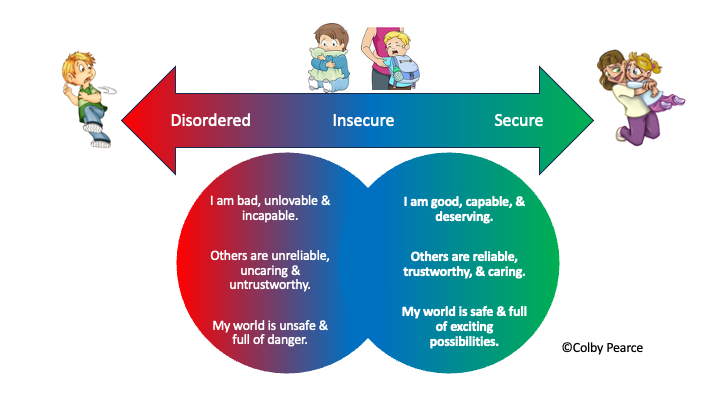
A particular aspect of attachment style is its relationship to the beliefs a child develops and maintains about themselves, others, and their world. In my writing I refer to these beliefs as “Attachment Representations”. In the attachment literature they are also referred to “Internal Working Models”. These are beliefs, usually held sub-consciously, that serve to orient the child or young person’s approach to life and relationships.
In my work and my writing I talk about two types of attachment representation. Secure attachment representations are those that develop in response to consistent, nurturing care. They incorporate beliefs that the child is lovable, capable, and worthy, that others are reliable, responsive, and trustworthy, and that the world is safe. Disordered attachment representations are those that develop in response to abusive and/or inadequate care and adverse relational experiences. They incorporate beliefs that the child or young person is bad, unworthy, and helpless, that others are mean, uncaring, and untrustworthy, and that the world is unsafe.
Secure attachment representations are at their most influential when the child or young person has developed a secure attachment style, or when the child or young person is interacting with an adult towards whom they have a secure attachment relationship. Disordered attachment representations are at their most influential when the child or young person has developed a disorganised or disordered attachment style, or when interacting with an adult towards who they have a disorganised attachment relationship.
The clear preference is for children and young people to approach life and relationships predominantly under the influence of secure attachment representations. This means that the focus of our endeavours is the promotion of a secure attachment style through secure attachment relationships. Where a child or young person approaches life and relationships under the influence of secure attachment representations they think more positively, feel better, behave better, and regulate their behaviour in consideration of their own inherent self-worth and the relationships that support this.
Reflection:
- Which attachment representations do you think the child or young person you work with or care for have the strongest influence over the way they approach life and relationships?
- What behaviours do you see that support this conclusion?
Click here to enter the next page.
Click here to purchase the PDF Handbook for this self-paced learning module.
